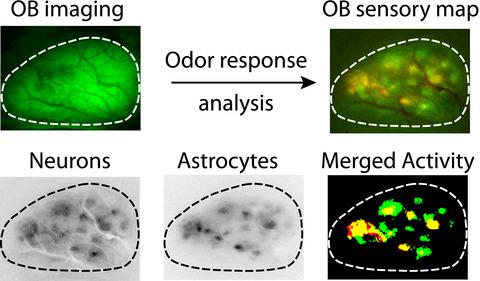当前位置:
X-MOL 学术
›
J. Neurosci. Res.
›
论文详情
Our official English website, www.x-mol.net, welcomes your
feedback! (Note: you will need to create a separate account there.)
Parallel astrocyte calcium signaling modulates olfactory bulb responses.
Journal of Neuroscience Research ( IF 2.9 ) Pub Date : 2020-05-19 , DOI: 10.1002/jnr.24634 Kevin Ung 1 , Burak Tepe 1 , Brandon Pekarek 2 , Benjamin R Arenkiel 1, 2, 3 , Benjamin Deneen 1, 4, 5
Journal of Neuroscience Research ( IF 2.9 ) Pub Date : 2020-05-19 , DOI: 10.1002/jnr.24634 Kevin Ung 1 , Burak Tepe 1 , Brandon Pekarek 2 , Benjamin R Arenkiel 1, 2, 3 , Benjamin Deneen 1, 4, 5
Affiliation

|
Astrocytes are the most abundant glial cell in the central nervous system. They modulate synaptic function through a variety of mechanisms, and yet remain relatively understudied with respect to overall neuronal circuit function. Exploiting the tractability of the mouse olfactory system, we manipulated astrocyte activity and examined how astrocytes modulate olfactory bulb responses. Toward this, we genetically targeted both astrocytes and neurons for in vivo widefield imaging of Ca2+ responses to odor stimuli. We found that astrocytes exhibited odor response maps that overlap with excitatory neuronal activity. By manipulating Ca2+ activity in astrocytes using chemical genetics we found that odor‐evoked neuronal activity was reciprocally affected, suggesting that astrocyte activation inhibits neuronal odor responses. Subsequently, behavioral experiments revealed that astrocyte manipulations affect both odor detection threshold and discrimination, suggesting that astrocytes play an active role in olfactory sensory processing circuits. Together, these studies show that astrocyte calcium signaling contributes to olfactory behavior through modulation of sensory circuits.
中文翻译:

平行星形胶质细胞钙信号传导调节嗅球反应。
星形胶质细胞是中枢神经系统中最丰富的神经胶质细胞。它们通过多种机制调节突触功能,但对于整体神经元回路功能的研究仍然相对不足。利用小鼠嗅觉系统的易处理性,我们操纵星形胶质细胞的活动并检查星形胶质细胞如何调节嗅球反应。为此,我们通过基因靶向星形胶质细胞和神经元,对 Ca 2+对气味刺激的反应进行体内宽场成像。我们发现星形胶质细胞表现出与兴奋性神经元活动重叠的气味反应图。通过使用化学遗传学操纵星形胶质细胞中的 Ca 2+活性,我们发现气味诱发的神经元活动受到相互影响,这表明星形胶质细胞的激活抑制神经元的气味反应。随后,行为实验表明,星形胶质细胞的操作会影响气味检测阈值和辨别能力,这表明星形胶质细胞在嗅觉感觉处理回路中发挥着积极作用。总之,这些研究表明星形胶质细胞钙信号传导通过调节感觉回路有助于嗅觉行为。
更新日期:2020-06-25
中文翻译:

平行星形胶质细胞钙信号传导调节嗅球反应。
星形胶质细胞是中枢神经系统中最丰富的神经胶质细胞。它们通过多种机制调节突触功能,但对于整体神经元回路功能的研究仍然相对不足。利用小鼠嗅觉系统的易处理性,我们操纵星形胶质细胞的活动并检查星形胶质细胞如何调节嗅球反应。为此,我们通过基因靶向星形胶质细胞和神经元,对 Ca 2+对气味刺激的反应进行体内宽场成像。我们发现星形胶质细胞表现出与兴奋性神经元活动重叠的气味反应图。通过使用化学遗传学操纵星形胶质细胞中的 Ca 2+活性,我们发现气味诱发的神经元活动受到相互影响,这表明星形胶质细胞的激活抑制神经元的气味反应。随后,行为实验表明,星形胶质细胞的操作会影响气味检测阈值和辨别能力,这表明星形胶质细胞在嗅觉感觉处理回路中发挥着积极作用。总之,这些研究表明星形胶质细胞钙信号传导通过调节感觉回路有助于嗅觉行为。











































 京公网安备 11010802027423号
京公网安备 11010802027423号